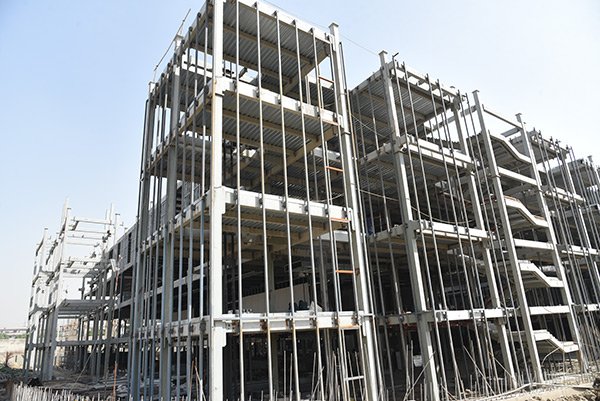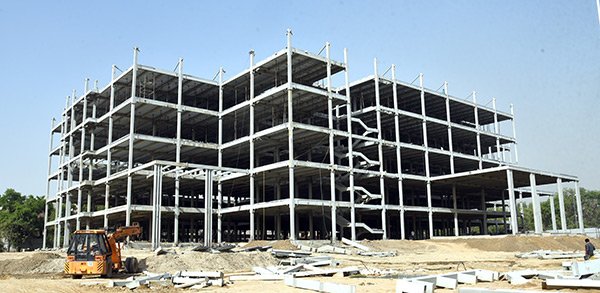He is a veteran with 20 years of experience in the steel producing industry. He has been the origin of some major structural steel products… He actively grabs & creates opportunities for the steel & construction industry to grow & evolve & he is all fired up to bring about the next phase of change…
Here’s Mr. Anubhav Gupta, Chief Strategy Officer of APL Apollo Tubes sharing his wisdom with us.
Being one of the country’s largest structures steel tube producers how has been your journey?
It’s been quite an exciting 20 years. When we started producing structural steel tubes, the steel tube industry was not square or rectangular at that time; instead it was round and circular products. The main application was hardly structural; it was mainly used for water, oil & gas transportation. APL Apollo was the first company to introduce square and rectangular tubes and we created products for special steel applications like construction because square and rectangular tubes had better load bearing capability and better aesthetics as compared to the round pipes. We were the first company to create this market.
We established a strong distribution network to push our products down the channel, we always came up with new and innovative products with different sizes and shapes which replaced the conventional construction products. So, our journey and progress has been quite an exciting one.
Our last ten year CAGR revenue is 20% and even in the last five years when the growth rates had come down because of demonetization, GST, the Covid-19 wave one, followed by the second wave, and now all the disruption caused by the Russian-Ukraine war, our last five years CAGR is at 15%; this shows the resilience of our business model. Hopefully we will continue to grow at the same pace may be higher as well because of our new products like structural steel tubes, which will give us an incremental growth and we can continue to grow at a very high pace.
APL Apollo believes in the philosophy of Make in India. Can you throw some light on the same?
We are among the largest buyers of steel in India and 99 per cent of our steel is procured from local manufacturers. India produces around 110 million tons of steel, if we exclude exports, the domestic market is 90 million tons, and we are buying almost 2 million which makes us one of the largest steel buyers in India. So it can be said that we here at APL Apollo give very high weightage to make in India concept and promote local manufacturers over international brands. Even our website is designed around the theme of ‘Made of steel Made of India’. In short, we buy steel of India and the products that we produce are one of the first kinds in the world. We want to make India as the manufacturing hub of structural steel tube products.

What is the uniqueness of the products offered by APL Apollo?
Our products are divided into five categories, and there are 1500 SPUs divided among these five categories. One of the categories, in a way, monetizes the low value add, where we compete with the large and small manufacturers in India. The other four categories which are our value-added categories, for example, light structural tubes, heavy structural tubes, coated tubes and the home improvement tubes make up about 50 per cent of our portfolio.
Products like square tubes, octagonal tubes, hexagonal tubes, D-shaped tubed, elliptical tubes, reflector tubes, fencing shaped tubes, zinc coated tubes, galvanized tubes, and handrails for light load grill application or furniture application and now we are starting with color coated tubes. In light weight section, we are making tubes starting from 500 mm to 1500 mm. All these are super high value products with very little competition. What adds uniqueness to APL Apollo’s products is that most of them are manufactured in India.
APL Apollo has such a large production of different sections of steel. Can you throw light on your manufacturing facilities?
We have ten plants across all the four zones in India. The rationale behind having these branches across all zones is to be near the raw material supply and to the end market since there are many governing factors when it comes to supply and logistics of steel tubes. We are also closer to the plants of our steel producers. In North, there are four plants which are fed from one of the best steel producers; in West there is one plant which is fed from another steel producer in Bangalore; there are three plants again being fed from one steel producer in Raipur which covers Central India and in East India also gets its supply from one steel producer.
All the ten plants are closer to our end markets where large warehouses stock our products and in turn meet the market demand. Both inbound and outbound freight will thus be taken care by locating these plants at specific locations and then also provide timely supply to the distributor. Raw material component is very crucial so we wouldn’t want to stock basic coils in our plants.
Being one of the key steel suppliers in the country, what is your take on the Indian Steel Construction Industry?
Currently, we are promoting more and more usage of steel in the construction industry. Right now, it is a mixture of TMT bar and RCC, but TMT bar is produced from recycled steel, which has low quality and RCC has its own challenge of delays in the construction timeline because of various factors. We at our end are promoting steel tubular consumption in a big way because that can reduce the overall construction time for a project significantly. It also benefits the customer in saving costs, whether in the form of higher carpet area or it could be in the form of interest cost savings since the project would finish earlier. It can also aid in procuring advanced cash flow since the advanced cash flow is beneficial in construction. It is also environment friendly because unlike RCC, where one needs to add cement and require groundwater, steel construction does not have any such requirements.
We believe that the future of construction is steel, not TMT bars but tubular steel. We are getting very good response from the client and the influencers in the construction industry, whether they are architects, structural engineers, or contractors. We are very confident that tubular steel structures will play a great role in the Indian Construction Industry in the near future.
What are the challenges faced by the steel suppliers in the country and how do you think government can aid in overcoming these challenges?
For the downstream producers, we are pretty much okay with the government policies. Pertaining to steel producers, the Indian Government has stayed away from any kind of regulations. Only recently the government has imposed export duty on steel because of the global inflation which is taking place in a big way.
Having said that, in my opinion, this is a short-term issue and it will settle down once the price stabilizes. So, apart from this, I think the government has stayed away from any kind of regulation in the steel sector. The government can of course take steps to boost the consumption of steel in construction since it has set very aggressive codes for the climate control to save the environment by ensuring that the cutting down of trees is prohibited. It can add regulations to control construction with RCC which requires raw materials like cement and high water consumption and causes air pollution. Additionally, there is low-grade steel used for making pipes called scrap steel, colloquially called as patra, which does not have any quality standards. The government should make sure that any product that are sold, should have a proper quality standard.
Can you share some landmark project where APL Apollo’s hollow steel sections have been used?
We have been trying to promote Steel Building Solution concept since past two years. Last year, the New Delhi government, along with PWD of Delhi, agreed to construct seven hospitals with steel tubes. Today, these hospitals have been given sites at seven different locations. The superstructures of all these hospitals were ready within three to four months of average time. Almost 15,000 ton of steel has been produced, supplied, fabricated, and directed on site. These G+4, G+5G story towers are one of its kind projects where the entire structure is built entirely on tubular sections. There is no conventional construction materials used like TMT bars or RCC. This is going to set an example in the country wherein India can also finish buildings in six to seven months’ time, which has been only heard of in countries like China, where large buildings are constructed in about half a year’s time. Once these projects are executed, this is going to provide massive opportunity for APL Apollo. We have plans to introduce 500×500 mm square diameter tubes and even higher sections in the next twelve months, we are very serious to grab every opportunity and evaluate this new aspect of steel construction in India.
How do you think technology will help transform Indian steel construction industry?
The tubular technology is new; it is building possibilities across the world. Technology is all about saving time, completing projects ahead of or on schedule, saving the environment and saving costs for the clients. It also maintains quality standards; there are so many incidents of buildings and bridges collapsing. So, technology must play a very important role to meet schedules, make sure the quality is good, the cost efficiency for the clients and also to save the environment. Bigger contractors are adopting ERP based systems to minimize the timeline of the project and save cost. Having said that, in terms of new technology, they still need to be more flexible, the push must come from the influencers like the architects or structural consultants, project management consultants, etc. Our goal will be to reach out to such people in the industry so that they can adopt new technologies in the near future.
What is your take on steel hollow sections v/s other steel materials?
We conducted research with IIT Roorkee, one of the prominent structural engineering institute in India; and have evaluated many global studies which states that hollow steel section has better weight to strength ratio compared to an ISMB section. So, infrastructure is built of 100 tons using ISMB while the same structure can be like built with 80 to 90 tons of hollow steel sections. So, this means, hollow steel sections can lead to more optimized structure with less steel consumption and less project cost; this is exactly what we demonstrated in the hospital project that I mentioned above. Meanwhile, we are also working with many developers and architects where we have demonstrated that the building gets more optimized using hollow steel sections.

What is your action plan for the next five years?
We must grow in the two segments which are new for us. Firstly, the super heavy structural tubes, wherein we are coming up with 500×500 mm square section which will start in next three months. We are also coming up with even larger sections up to 1000×1000 mm soon.
Secondly, color coated tubes. Again, these are one of its kind products used globally wherein it can improve the aesthetics of the steel section. Once colored hollow steel sections are available, the sections will not be sent to the paint shop for the finishing. This will increase efficiency of our fabricators and it will bring down the overall cost of the finished product.
In the next five years we think these two products can bring about a huge growth to APL Apollo. We already have our capacity at 2.6 million tons which is about 70% in rise. We are also coming up with one and a half million ton of new capacity in Raipur which will be divided between color coated tubes and super heavy structural tubes.
We want to take our sales volume to 4 million tons from 1.7 million tons which we did last year. So, this implies a CAGR of 25 per cent to 30 per cent which is faster than what we have grown in the last ten years. We have set plans for ourselves, and we are very confident that this is possible, given that the construction industry has improved down cycle for the last ten years; there should be tailwind. The developers, the clients are looking for a faster way of construction which can help save environment as well as the cost at the same time. So, we are very bullish for the next five years.
What is your success mantra?
The success mantra for our organization is four terms- innovation, cost efficiency, value addition and distribution. These are the four strategies for success on which we have played to our strength in the last ten years and for next five years also we are not going to change this. Apart from that, the new mantra which we are going to work is brand equity. We have started working on it and this is the fifth strategy which will play a very significant role as well.






